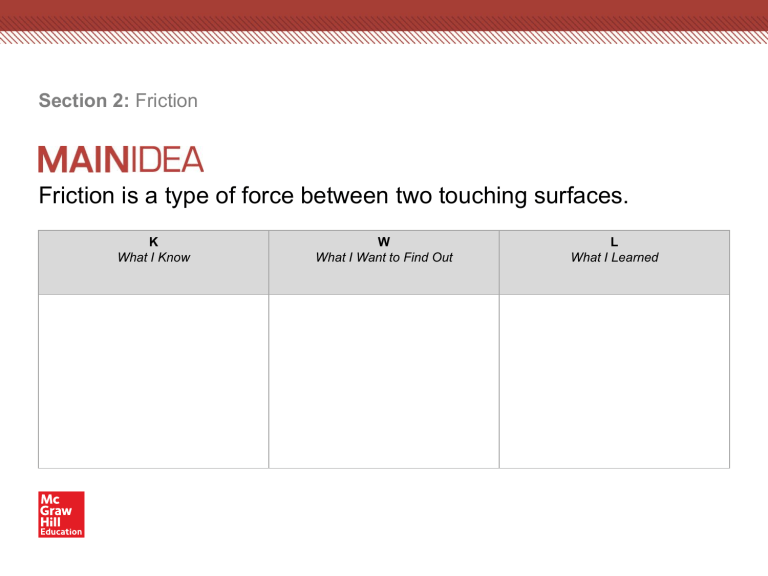
Section 2: Friction Friction is a type of force between two touching surfaces. K What I Know W What I Want to Find Out L What I Learned Essential Questions • What is the friction force? • How do static and kinetic friction differ? Copyright © McGraw-Hill Education Friction Vocabulary Review New • • • • • force Copyright © McGraw-Hill Education kinetic friction static friction coefficient of kinetic friction coefficient of static friction Friction Kinetic and Static Friction • Friction is a force that opposes the motion of two surfaces that are in contact with each other. • There are two types of friction—kinetic friction and static friction. • Static friction is the force exerted on one surface by another when there is no motion between the two surfaces. • For example, the force applied to the couch below is balanced by the static friction force. Copyright © McGraw-Hill Education Friction Kinetic and Static Friction • If you push hard enough, the couch will begin to move and kinetic friction will act on it. • Kinetic friction is exerted on one surface by another when the two surfaces rub against each other because one or both of them are moving. Copyright © McGraw-Hill Education Friction Kinetic and Static Friction • Frictional force depends on the materials that the surfaces are made of. • The different lines correspond to dragging a block along different surfaces. Copyright © McGraw-Hill Education Friction Kinetic and Static Friction • The slope of this line is the coefficient of kinetic friction (μk) between the two surfaces and relates the frictional force to the normal force, as shown below. Kinetic Friction Force Ff, kinetic μk FN • Notice that the normal force (FN) also plays a role in the size of the friction force. • Similarly, μs is the coefficient of static friction between the two surfaces. Static Friction Force Ff, static μsFN • μsFN is the maximum static friction force that must be overcome before motion can begin. Copyright © McGraw-Hill Education Friction Kinetic and Static Friction Copyright © McGraw-Hill Education Friction FN Kinetic and Static Friction vg Ff Fchild Use with Example Problem 3. Fg Problem A child drags a heavy, rubber-soled shoe by its laces across a sidewalk at a constant speed of 0.35 m/s. The shoe has a mass of 1.56 kg and the coefficient of kinetic friction is 0.65. What is the force exerted by the child? (Assume the sole is in contact with the sidewalk, not bouncing around and that the child pulls horizontally.) Response SKETCH AND ANALYZE THE PROBLEM • Draw a vector diagram. • List the knowns and unknowns. Copyright © McGraw-Hill Education KNOWN v = 0.35 m/s m = 1.56 kg μk = 0.65 UNKNOWN Fchild = ? SOLVE FOR THE UNKNOWN • Because the shoe is not accelerating in the y-direction, Fnet, y = 0. • Thus, the normal force and the shoe’s weight are equal in magnitude. FN Fg mg • Because the shoe is not accelerating in the x-direction, Fnet, x = 0. • Thus, the force the child exerts and the frictional force are equal in magnitude. Fchild Ff μk FN μk mg 0.651.56 kg9.8 N/kg 9.9 N EVALUATE THE ANSWER • Force is in newtons, so the units are correct. Friction Kinetic and Static Friction Ff FN Fchild Fg a Use with Example Problem 4. Problem If the child in the previous Additional In-Class SOLVE FOR THE UNKNOWN Example pulls with an extra 2.0 N in the • Find the net force in each direction. horizontal direction, what will be the • Fnet, y = 0 and FN = mg, as it did in the acceleration of the shoe? previous example. • Ff is same as it was in the previous Response example, so Fnet, x = Fchild − Ff = 2 N. SKETCH AND ANALYZE THE PROBLEM • Use Newton’s second law. • Draw a force diagram. • List the knowns and unknowns. KNOWN UNKNOWN Fchild = 11.9 N a=? m = 1.56 kg μk = 0.65 Copyright © McGraw-Hill Education Fnet ma Fnet, x 2.0 N ax 1.3 m/s2 m 1.56 kg EVALUATE THE ANSWER • 1.3 m/s2 is about (1/8)g, so it is a reasonable acceleration. Friction Review Essential Questions • What is the friction force? • How do static and kinetic friction differ? Vocabulary • kinetic friction • static friction Copyright © McGraw-Hill Education • coefficient of kinetic friction • coefficient of static friction Friction

